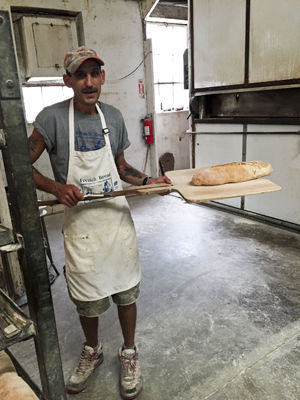Reflections of old
Published 3:26 pm Wednesday, September 23, 2015

- Carl ‘Hollywood’ Lajaunie arrives at 1 a.m. to begin the baking process before delivery trucks carry the famous French bread to markets.
Travel Acadiana with a food historian
Paul Theriot bought a grocery store in 1941 at the corner of Hacker and Julia streets. He bought the business but not the property. After being drafted into World War II, his parents and sister Irene managed it while he was overseas.
In 1946 after returning from the war, Paul Theriot bought the whole block at the corner of E. Pershing and Julia. Theriot’s Deli and Market moved to 330 Julia St. where it remains today as a diner.
His son David Theriot, the third generation owner, said his father tore down the house next door and built two houses, one for himself the other for his brother. It was there David Theriot, two brothers and one sister were raised. Their family home is reflected in the window of a picture shot Monday featuring the handmade sign of the diner’s daily specials.
Theriot’s is one of the featured eateries in a new book by St. Martin Parish author Dixie Poché, “Classic Eateries of Cajun Country.”
Ed Rose, 58, a companion of Poché’s, helped with the research for the book, eating at potential restaurants and markets. He said as a boy he went with his mother as she shopped at Theriot’s buying meats, sausage and hog head cheese, something still offered in addition to the daily lunches.
“It was a typical neighborhood grocery store with the meat market in the back,” Rose said. “I can drive you all through the city and show you places where old neighborhood grocery stores once stood.”
David Theriot, 63, said when he was a boy they delivered groceries in trucks and on bicycles.
“Even though you had stores on every corner, they were neighborhood groceries,” Theriot said. “People would call and order their groceries and on Saturdays the ladies would do their big shopping. They’d come and sit down, watch the people go by, visit and shop.”
Theriot said one lady, the eldest in the neighborhood, would often sit all day. More than once, she stayed too long. She told them twice her soup burned because she had left it on the stove over a low heat for her trip to Theriot’s.
“That’s what it was like until cars came and people starting working,” he said. “Times change, so we adjusted to the lunch business.”
David Theriot said the corner grocery was the place all the young people in the family worked to learn basic work ethics. Cousins and friends’ children also were hired during summers off from school or afternoons during the school year.
Rose, a native of New Iberia, made many of the suggestions in the Teche Area for the Cecilia native to research and explore for inclusion in her book. Rose said the book cost him a fortune. Every place they went throughout Acadiana he would take along an ice chest and ultimately fill it with delicacies and specialties featured at the mom and pop, local eateries they were testing.
Poché said not every place they visited became part of her book about classic eateries, which took about a year to complete. She said sometimes the people weren’t interested in what she was doing or didn’t engage in conversation stimulating to the author with an interesting story about the food, location or family ownership.
“It took me all my life to write this book,” Poché said. “When you think about things you want to do, opportunities, incorporating those things in your writing, the subject came naturally. My aunt and uncle had a grocery store in Cecilia, Huval’s, where I worked as a teenager. Being there, learning about the business, their work ethics, customer service, the old country store and they made boudin. It’s just part of me.”
Poché said she is not an expert on food. Rose is a better cook, but her interests focused on the history and researching the foods in Acadiana. Her choices for writing about an eatery were not necessarily centered around the best food, but the best stories.
“My personal criteria was to choose an old business or an old building that has a restaurant,” Poché said. “Like Café des Amis in Breaux Bridge. The restaurant is not so old, but the building is. When I was growing up, it was a fabric store and at one time it housed caskets for Pellerin Funeral Home.”
Poché has a minor in Library science and enjoyed using those skills in her research. She also went to visitor centers, asked a lot of questions and one by one traveled the areas to remote locations as well as popular restaurants throughout Acadiana.
“I like to eat, but it’s the atmosphere, the locals, the people you meet, the ‘something different.’ Like in New Iberia, there are really so many more I could have written about.
“LeJeune’s Bakery in Jeanerette was an automatic. It started in 1884. They still do French bread by hand, in the original building, like they always have,” Poché said.
Some food products also are featured to fill out the book like Konriko Rice Mill, Tabasco and Steen’s Pure Ribbon Cane Syrup. She wanted to do old time things, traditions, the nostalgic that would also meet the publishers requirements. There is a glossary of popular Cajun dishes, a recipe section and pictures of times past.
Nepotism was not the only reason to include Poché’s Market in Breaux Bridge or Pat’s (Huval) Fisherman’s Wharf Restaurant in Henderson, but they are relatives, she said and would have liked to have covered more establishments, but space was limited.
“There were a couple of places, which I won’t mention, I did not care for the food or the atmosphere,” she said. “There are so many places, but I just had to choose.”
Poché is scheduled for a book signing on Oct. 10 at Books Along the Teche during the World Championship Gumbo Cook-off. Her book launch will be held at 11 a.m. Saturday at the Southern Food and Beverage Museum in New Orleans, a part of the boucherie food demonstration.





